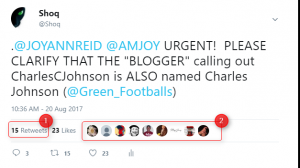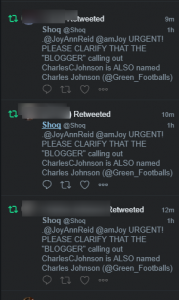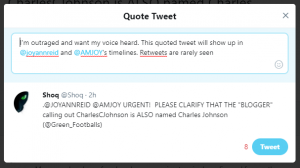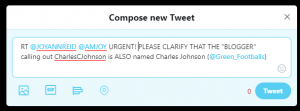This post has been updated.
Update: See latest Google Hit Counts: #Followfriday vs. #FF Click here to jump.
What is the #FF Hashtag?
It's just a much shorter version of the familiar #followFriday hashtag seen far too often on Twitter (and now other social networks, as well). And as I will explain below, it's also a tag that denotes a ritual behavior that has serious issues and could really benefit from a major rethink.
It's not news to my followers that the concept of #Followfriday is a ritual that I've been openly contemptuous of, but like many trends, such a genie is hard to stuff back in its bottle. But if people are going to use a bad idea, I reasoned, at least they should do it efficiently. Why use 12 precious characters when just 2 would do the same work.
So a few weeks after the ritual was clearly entrenched, I urged my friends and followers to just use both tags for a while, until the #ff caught on with the Twitterverse. After 11 months it seems that's finally happening, and it's now familiar enough that many people are finally dropping the longer original. Good riddance.
But there is much more wrong with this practice than some wasted character space, and I'd like to examine it and propose a retrofit for something popular, but not very useful…yet.
What's Wrong With The #FollowFriday Ritual?
It's just a bad idea, in my opinion. It's noisy, inefficient, quasi-elitist, impractical, disruptive, and just encourages a kind of cliquish behavior that social media has been wonderful at avoiding on many levels. It can also just make people feel bad. I have nearly 6000 followers. I follow about 2500. What does it say to thousands of people that I really like when I single out only a handful of them each Friday?
Of course they know that I can't possibly recommend everyone, but they STILL feel I did not recommend THEM. Even if they are not consciously acknowledging it, it's there as a resident feeling in most of us. And that creates a social peer tension that is simply unnecessary, in my view.
The efficacy of the ritual is small anyway. People feel obligated to engage in it, and wind up just blasting out enough friends so their closer friends won't feel left out. People receiving these "lists" almost never follow everyone–or even more than a handful of them. Many follow none of them at all.
While I certainly can't claim formal research, my own experience, and asking amongst friends, is that typically, we might recognize a name we've already seen and think "ok, well there's that @name again, recommended by someone I already follow, so I'll follow them." But that's about the extent of how much we use these "recommendations."
And such a modest value-added to a user's social graph hardly justifies list after list after list of #FF posts flooding out of the Twitter firehose from millions of users each and every Friday. It's nearly zero signal, and almost all noise. My followers know that I often joke about evacuating or taking shelter when these Friday "Tweet bombs" start to fall.
For a really entertaining comic about #FF, that makes my point in a creative way, check this out: "How Follow Friday is supposed to work."
Is it Wrong To Recommend People?
Nope. And I do that often (but not just on Fridays). But making one or two recommendations, and being specific about why, is a very different message from blasting out some random collection of names that comes off more as "people I like," rather than people who bring value for others to follow. And it's very hard to read news or other important tweets when 150 "name lists" are flooding into our streams. It's intrusive, disruptive, and often just damned annoying.
Why Do I Even Explain All This?
Because people often include me in their #FF lists, and I do not mean to seem ungracious or ungrateful for the kindness and consideration when they do. I am pleased they think well enough of me to do this. But I would not fault them if they didn't, and actually wish they didn't do #FF at all (at least in its present form).
But as critical as I am of the practice, I am also fully aware that #FollowFriday is a fun social activity, and can be a useful way to pass along interesting or important people. I would like to see some new method of recommending people emerge that is less formal, and far more effective. I just happen to have such an idea lying around here somewhere :)
How Would a New #FF Method Work?
I would like to see the entire meme refashioned from a day-specific "#followFriday," to a far more general, "Friends to Follow" (#FF) recommendation which can be used any day of the week, at any hour, rain or shine.
Note: the actual designation is just a working name. It really doesn't matter what we call it, and at some point, some name will just stick. I also heard and liked "Followable Folks." So long as the letters stay the same, use what works.
With these "Anytime #FFs," Fridays won't come to a standstill as millions of random messages get blasted into the stream, trashing everyone's timeline. If you know a friend who knows a lot about something, and feel they would be valuable to your followers, just go ahead and say so. For example:
#FF my friend @tesibria. A brilliant lawyer who tracks the Birthers.
#FF @LizzWinstead, co-creator of the daily show. You can think AND laugh (and even chew gum) at same time.
And that's all there is to the idea. Simple, flexible, and far more interesting and informative, in my opinion. And since they can be sent out at any time, there's no need to wait for some ritualistic special day, and no good friend or associate needs to feel "left out," until such time when they've NEVER seen one from you. (But that's their drama–and yours.:)
An important additional benefit is that 3rd party application developers can easily slurp this new meta data from the twitter stream, and feed it into lists, databases, groups, analytic metrics… and whatever. Best of all, now you can do a search for "@someone and #FF" and harvest all the recs they've made in past days or weeks.
But Can't Twitter Lists Be Used To Recommend
Sure, but you run into the same problem–and some new ones. And lots of decisions. Do you put ALL your friends in such a list, or just the ones you like? How big is the list? Does it just become another variation on your entire follow list? Do you have many lists by topic? What makes these lists different from any topical group you chose to follow? Why are you recommending them? How much work do you want to do to maintain it? Lists are a tool. They can be a very good "recommending tool," but a fairly formal one. They not too useful as informal tool that can be used on a flexible, minute-to-minute, completely spontaneous basis.
Can This Idea Fly?
Sure, why not? #FF and MT are already catching on. What else did we have to do this year? This post is all that's needed to explain it. I plan to just start using Anytime #FFs immediately.
As with any idea I've come up with since I was old enough to say, "this really sucks," you and everyone you've ever known are free to completely ignore it :
Update 1: In December, 2010, I started noticing a number of people using the "#followanytime" tag. Ugh and more ugh. While it's certainly in the spirit of my ideas herein, and possibly even the direct result of them, I rejected that tag because it's just more characters to waste space. And it's also completely redundant. #FF's meaning is now clear to millions. It's a very small jump to using it "anytime," and as you can see by doing a Twitter search on any day of the week except Friday, miliions already are. Just say no to #followAnyday usage.
Update 2:
Google hits (as of Jan 21, 2011):
#FollowFriday = 510,000
#FollowAnyday = 324,000
#FF = 202,000,000
Google hits (as of March 4th, 2011):
#FollowFriday = 622,000
#FollowAnyday = 339,000
#FF = 454,000,000
Google hits (as of May 27th, 2011):
#FollowFriday = 1,480,000
#FollowAnyday = 1,160,000
#FF = 809,000,000
Google hits (as of Sept 16th, 2011):
#FollowFriday = 2,240,000
#FollowAnyday = 1,200,000
#FF = 1,180,000,000 (Nutz – probably just a google error )
Google hits (as of April 13th, 2011):
#FollowFriday = 3,700,000
#FollowAnyday = 5,960 (finally, this bad idea is dying out)
#FF = 13,600,000 (This seems more realistic. Google tweaked something)
Google hits (as of November 2nd, 2012):
#FollowFriday = 2,553,000
#FollowAnyday = 3,900 (Going, going.. )
#FF = 11,600,000
Clearly, #FF has failed in the marketplace of ideas :)
Related
How Follow Friday is Supposed To Work
.



